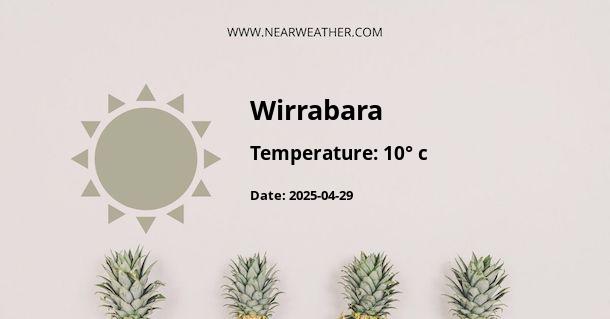Climate and Weather in Wirrabara, Australia
Located in the Mid North region of South Australia, Wirrabara is a small town known for its picturesque landscapes and unique weather patterns. The climate in Wirrabara is classified as Mediterranean, with distinct seasons throughout the year. In this article, we will explore the climate and weather in Wirrabara, providing detailed information about the temperature, rainfall, and other meteorological factors that influence the region.
Temperature
Wirrabara experiences warm to hot summers and cool winters, typical of a Mediterranean climate. The average daily maximum temperature in summer (December to February) ranges from 28 to 32 degrees Celsius (82 to 90 degrees Fahrenheit). However, temperatures can occasionally exceed 40 degrees Celsius (104 degrees Fahrenheit) during heatwaves.
Winter (June to August) in Wirrabara brings cooler temperatures, with average daily maximums ranging from 12 to 16 degrees Celsius (54 to 61 degrees Fahrenheit). The nights can get quite chilly, with temperatures dropping to around 5 degrees Celsius (41 degrees Fahrenheit).
Spring (September to November) and autumn (March to May) are transitional seasons in Wirrabara. During these periods, temperatures are milder, with average daily maximums ranging from 18 to 25 degrees Celsius (64 to 77 degrees Fahrenheit), making it a pleasant time to visit the region.
Rainfall
Wirrabara receives a moderate amount of rainfall throughout the year, contributing to the region's lush vegetation. The wettest months are typically between May and October, with an average monthly rainfall ranging from 30 to 60 millimeters (1.1 to 2.4 inches). The summer months, on the other hand, are relatively dry, with average monthly rainfall of around 10 to 20 millimeters (0.4 to 0.8 inches).
The rainfall in Wirrabara is influenced by both frontal systems and convective storms. Frontal systems, associated with cold fronts and low-pressure systems, bring steady rain to the region. Convective storms, on the other hand, are more localized and can result in heavy downpours, often accompanied by thunder and lightning.
It is worth noting that rainfall patterns in Wirrabara can vary from year to year, and the region is susceptible to periods of drought, especially during the summer months. Therefore, water conservation and efficient agricultural practices are crucial for the sustainability of the local ecosystem and economy.
Wind
Wirrabara experiences moderate winds throughout the year, with stronger gusts during certain weather systems. The prevailing winds usually come from the southwest, but they can vary depending on the location and time of year. These winds are influenced by the surrounding topography, including the nearby Mount Remarkable National Park.
During the summer months, the region can experience hot and dry winds known as "northerlies" or "northwesters." These winds can increase the fire risk in the area and have an impact on agricultural activities.
Sunshine Hours
Wirrabara enjoys a significant amount of sunshine throughout the year, contributing to the region's agricultural productivity. On average, Wirrabara receives around 8 to 9 hours of sunshine per day during the summer months, providing ample energy for plant growth and photosynthesis.
In winter, the sunshine hours reduce to around 5 to 6 hours per day. However, even during the cooler months, Wirrabara still experiences a considerable amount of sunlight, which is beneficial for outdoor activities and tourism.
Extreme Weather Events
Like many regions in Australia, Wirrabara is occasionally affected by extreme weather events. These events can include heatwaves, bushfires, thunderstorms, and even occasional snowfall.
Heatwaves can occur during the summer months, with temperatures soaring above 40 degrees Celsius (104 degrees Fahrenheit). These prolonged periods of extreme heat pose health risks and can have implications for agriculture and water resources.
Bushfires are a significant concern for Wirrabara and its surrounding areas, particularly during the dry summer months. The combination of hot and dry conditions, coupled with strong winds, can increase the fire risk. It is essential for residents and visitors to stay informed about fire danger ratings and adhere to any local fire restrictions in place.
Thunderstorms are more common during spring and summer, often accompanied by heavy rain, lightning, and strong winds. While they can bring much-needed rainfall to the region, severe thunderstorms can also result in flash flooding and damage to property.
Although rare, Wirrabara has recorded occasional snowfall during winter, creating a beautiful and unique sight in the area. These snow events are typically light and short-lived but add to the region's charm and attract visitors.
Conclusion
Wirrabara experiences a Mediterranean climate, characterized by warm to hot summers, cool winters, and moderate rainfall throughout the year. The region's unique weather patterns, including the occasional extreme events, contribute to its natural beauty and agricultural productivity. Whether you are a resident or a visitor, understanding Wirrabara's climate and weather can help you plan your activities and make the most of what this charming town has to offer.
A - Wirrabara's Latitude is -33.033329 & Longitude is 138.266663.
A - Weather in Wirrabara is 10° today.
A - Climate Conditions in Wirrabara shows few clouds today.
A - Humidity in Wirrabara is 84% today.
A - Wind speed in Wirrabara is 3.31 km/h, flowing at 91° wind direction. today.
